Food as a Cultural Domain: American and Indian Comparison
VerifiedAdded on 2022/10/02
|5
|1228
|117
Homework Assignment
AI Summary
This homework assignment delves into the cultural significance of food, focusing on a comparative analysis of American and East Indian food habits and sharing practices. The student begins by discussing the differences in hospitality and food sharing, highlighting the American emphasis on individuality versus the Indian emphasis on family and community. The analysis extends to observations in both home and office settings, noting similarities and differences in eating styles and the influence of cultural values. The assignment then explores data collection through interviews on healthy and unhealthy foods, relating the findings to Jill Dubisch's article on the health food movement and its cultural implications. The student interviewed two friends, Albert and Johnson, to gather their perspectives on healthy and unhealthy foods. The student then links their findings to Dubisch's article, which discusses the impact of healthy eating on physical and mental well-being. The assignment concludes with a reflection on the role of cultural values in shaping food habits and their broader impact.
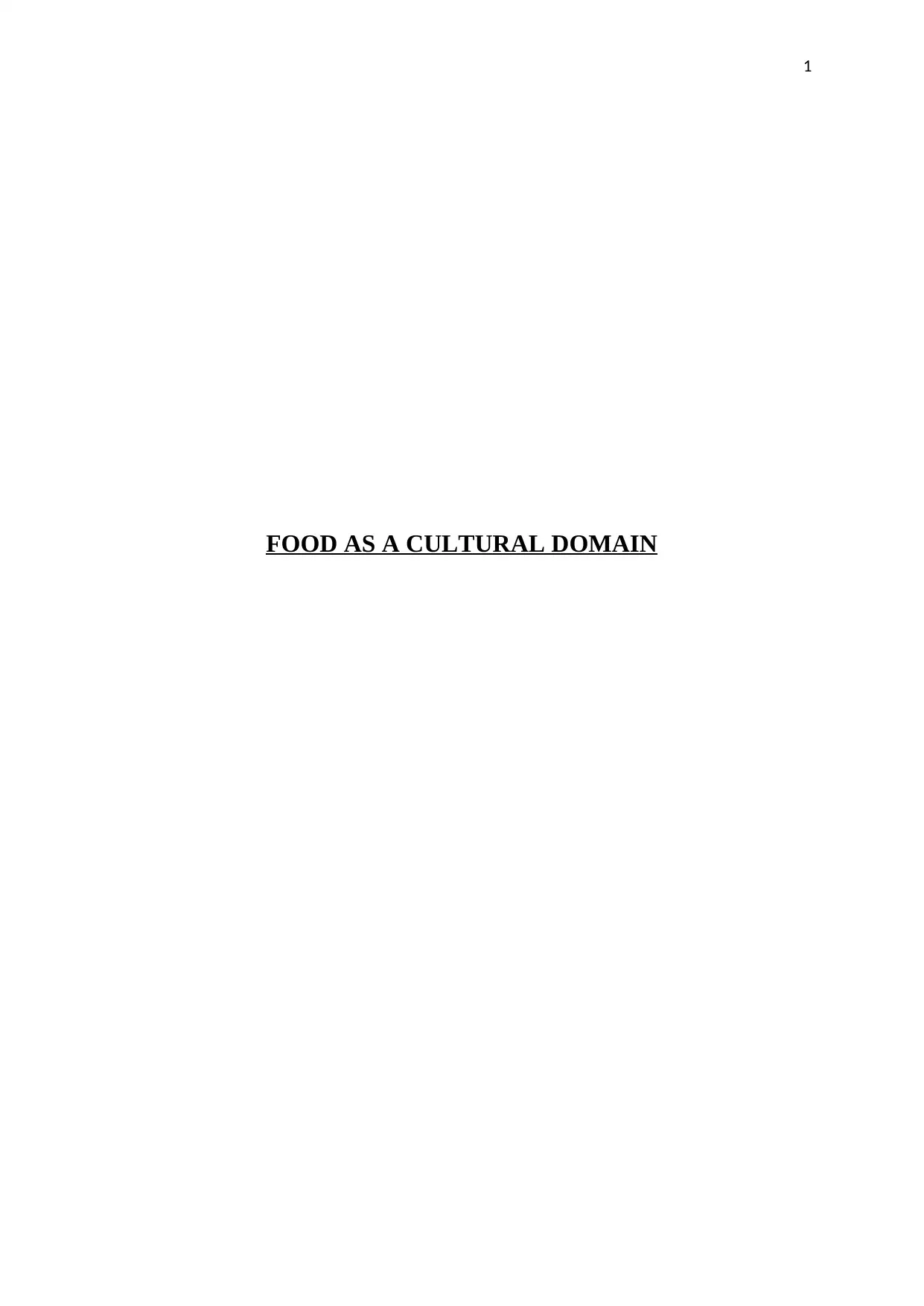
1
FOOD AS A CULTURAL DOMAIN
FOOD AS A CULTURAL DOMAIN
Paraphrase This Document
Need a fresh take? Get an instant paraphrase of this document with our AI Paraphraser
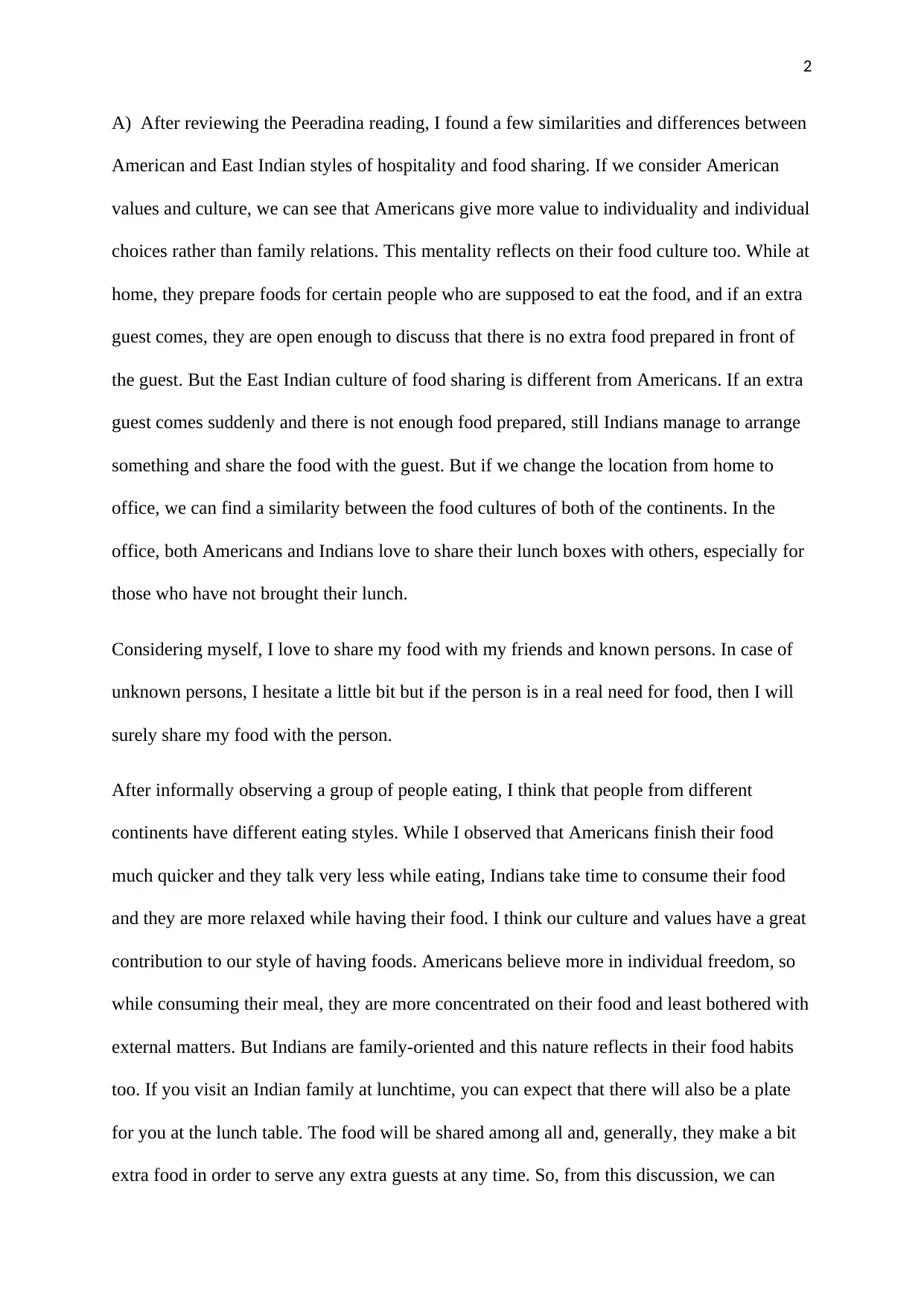
2
A) After reviewing the Peeradina reading, I found a few similarities and differences between
American and East Indian styles of hospitality and food sharing. If we consider American
values and culture, we can see that Americans give more value to individuality and individual
choices rather than family relations. This mentality reflects on their food culture too. While at
home, they prepare foods for certain people who are supposed to eat the food, and if an extra
guest comes, they are open enough to discuss that there is no extra food prepared in front of
the guest. But the East Indian culture of food sharing is different from Americans. If an extra
guest comes suddenly and there is not enough food prepared, still Indians manage to arrange
something and share the food with the guest. But if we change the location from home to
office, we can find a similarity between the food cultures of both of the continents. In the
office, both Americans and Indians love to share their lunch boxes with others, especially for
those who have not brought their lunch.
Considering myself, I love to share my food with my friends and known persons. In case of
unknown persons, I hesitate a little bit but if the person is in a real need for food, then I will
surely share my food with the person.
After informally observing a group of people eating, I think that people from different
continents have different eating styles. While I observed that Americans finish their food
much quicker and they talk very less while eating, Indians take time to consume their food
and they are more relaxed while having their food. I think our culture and values have a great
contribution to our style of having foods. Americans believe more in individual freedom, so
while consuming their meal, they are more concentrated on their food and least bothered with
external matters. But Indians are family-oriented and this nature reflects in their food habits
too. If you visit an Indian family at lunchtime, you can expect that there will also be a plate
for you at the lunch table. The food will be shared among all and, generally, they make a bit
extra food in order to serve any extra guests at any time. So, from this discussion, we can
A) After reviewing the Peeradina reading, I found a few similarities and differences between
American and East Indian styles of hospitality and food sharing. If we consider American
values and culture, we can see that Americans give more value to individuality and individual
choices rather than family relations. This mentality reflects on their food culture too. While at
home, they prepare foods for certain people who are supposed to eat the food, and if an extra
guest comes, they are open enough to discuss that there is no extra food prepared in front of
the guest. But the East Indian culture of food sharing is different from Americans. If an extra
guest comes suddenly and there is not enough food prepared, still Indians manage to arrange
something and share the food with the guest. But if we change the location from home to
office, we can find a similarity between the food cultures of both of the continents. In the
office, both Americans and Indians love to share their lunch boxes with others, especially for
those who have not brought their lunch.
Considering myself, I love to share my food with my friends and known persons. In case of
unknown persons, I hesitate a little bit but if the person is in a real need for food, then I will
surely share my food with the person.
After informally observing a group of people eating, I think that people from different
continents have different eating styles. While I observed that Americans finish their food
much quicker and they talk very less while eating, Indians take time to consume their food
and they are more relaxed while having their food. I think our culture and values have a great
contribution to our style of having foods. Americans believe more in individual freedom, so
while consuming their meal, they are more concentrated on their food and least bothered with
external matters. But Indians are family-oriented and this nature reflects in their food habits
too. If you visit an Indian family at lunchtime, you can expect that there will also be a plate
for you at the lunch table. The food will be shared among all and, generally, they make a bit
extra food in order to serve any extra guests at any time. So, from this discussion, we can
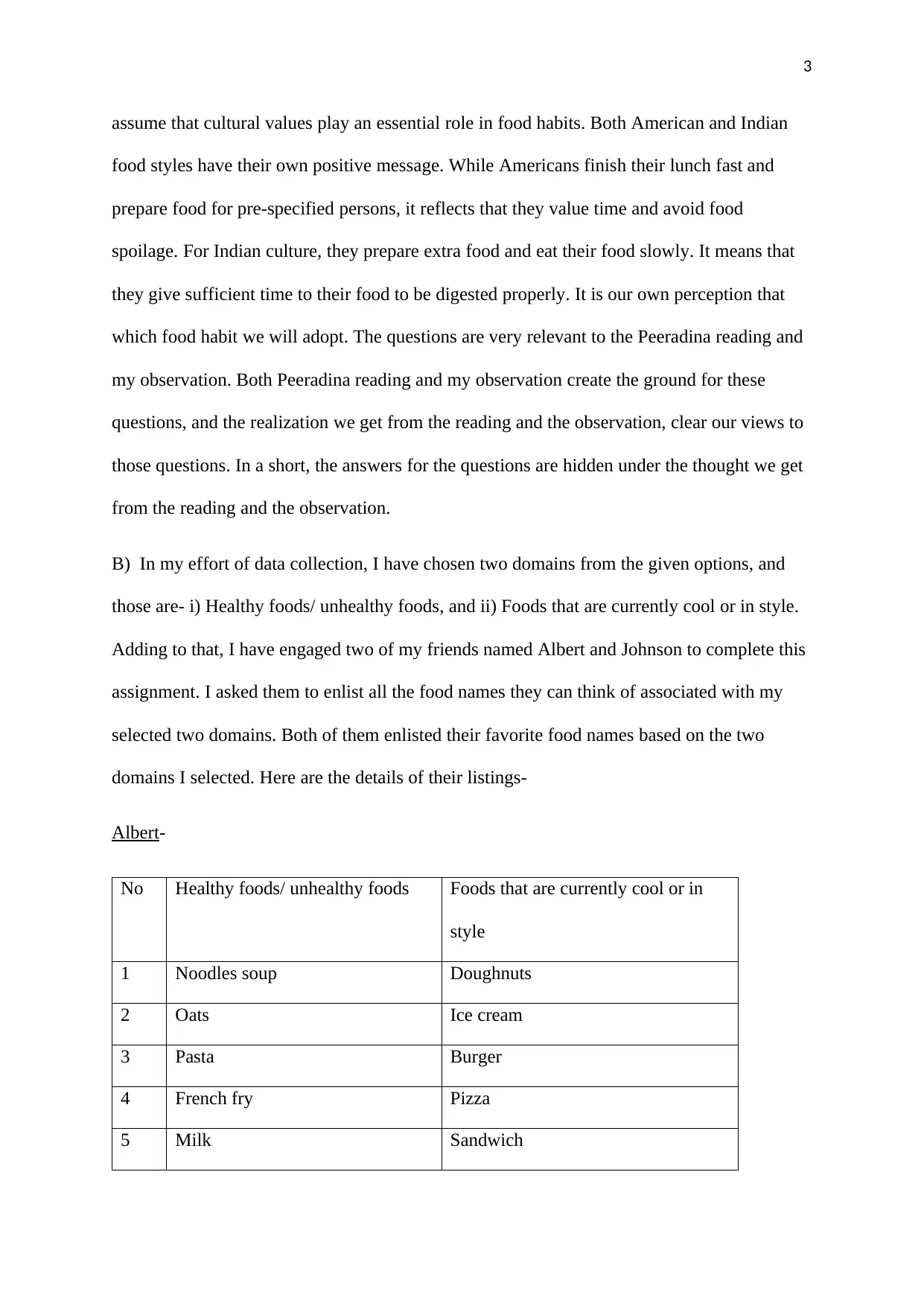
3
assume that cultural values play an essential role in food habits. Both American and Indian
food styles have their own positive message. While Americans finish their lunch fast and
prepare food for pre-specified persons, it reflects that they value time and avoid food
spoilage. For Indian culture, they prepare extra food and eat their food slowly. It means that
they give sufficient time to their food to be digested properly. It is our own perception that
which food habit we will adopt. The questions are very relevant to the Peeradina reading and
my observation. Both Peeradina reading and my observation create the ground for these
questions, and the realization we get from the reading and the observation, clear our views to
those questions. In a short, the answers for the questions are hidden under the thought we get
from the reading and the observation.
B) In my effort of data collection, I have chosen two domains from the given options, and
those are- i) Healthy foods/ unhealthy foods, and ii) Foods that are currently cool or in style.
Adding to that, I have engaged two of my friends named Albert and Johnson to complete this
assignment. I asked them to enlist all the food names they can think of associated with my
selected two domains. Both of them enlisted their favorite food names based on the two
domains I selected. Here are the details of their listings-
Albert-
No Healthy foods/ unhealthy foods Foods that are currently cool or in
style
1 Noodles soup Doughnuts
2 Oats Ice cream
3 Pasta Burger
4 French fry Pizza
5 Milk Sandwich
assume that cultural values play an essential role in food habits. Both American and Indian
food styles have their own positive message. While Americans finish their lunch fast and
prepare food for pre-specified persons, it reflects that they value time and avoid food
spoilage. For Indian culture, they prepare extra food and eat their food slowly. It means that
they give sufficient time to their food to be digested properly. It is our own perception that
which food habit we will adopt. The questions are very relevant to the Peeradina reading and
my observation. Both Peeradina reading and my observation create the ground for these
questions, and the realization we get from the reading and the observation, clear our views to
those questions. In a short, the answers for the questions are hidden under the thought we get
from the reading and the observation.
B) In my effort of data collection, I have chosen two domains from the given options, and
those are- i) Healthy foods/ unhealthy foods, and ii) Foods that are currently cool or in style.
Adding to that, I have engaged two of my friends named Albert and Johnson to complete this
assignment. I asked them to enlist all the food names they can think of associated with my
selected two domains. Both of them enlisted their favorite food names based on the two
domains I selected. Here are the details of their listings-
Albert-
No Healthy foods/ unhealthy foods Foods that are currently cool or in
style
1 Noodles soup Doughnuts
2 Oats Ice cream
3 Pasta Burger
4 French fry Pizza
5 Milk Sandwich
⊘ This is a preview!⊘
Do you want full access?
Subscribe today to unlock all pages.

Trusted by 1+ million students worldwide
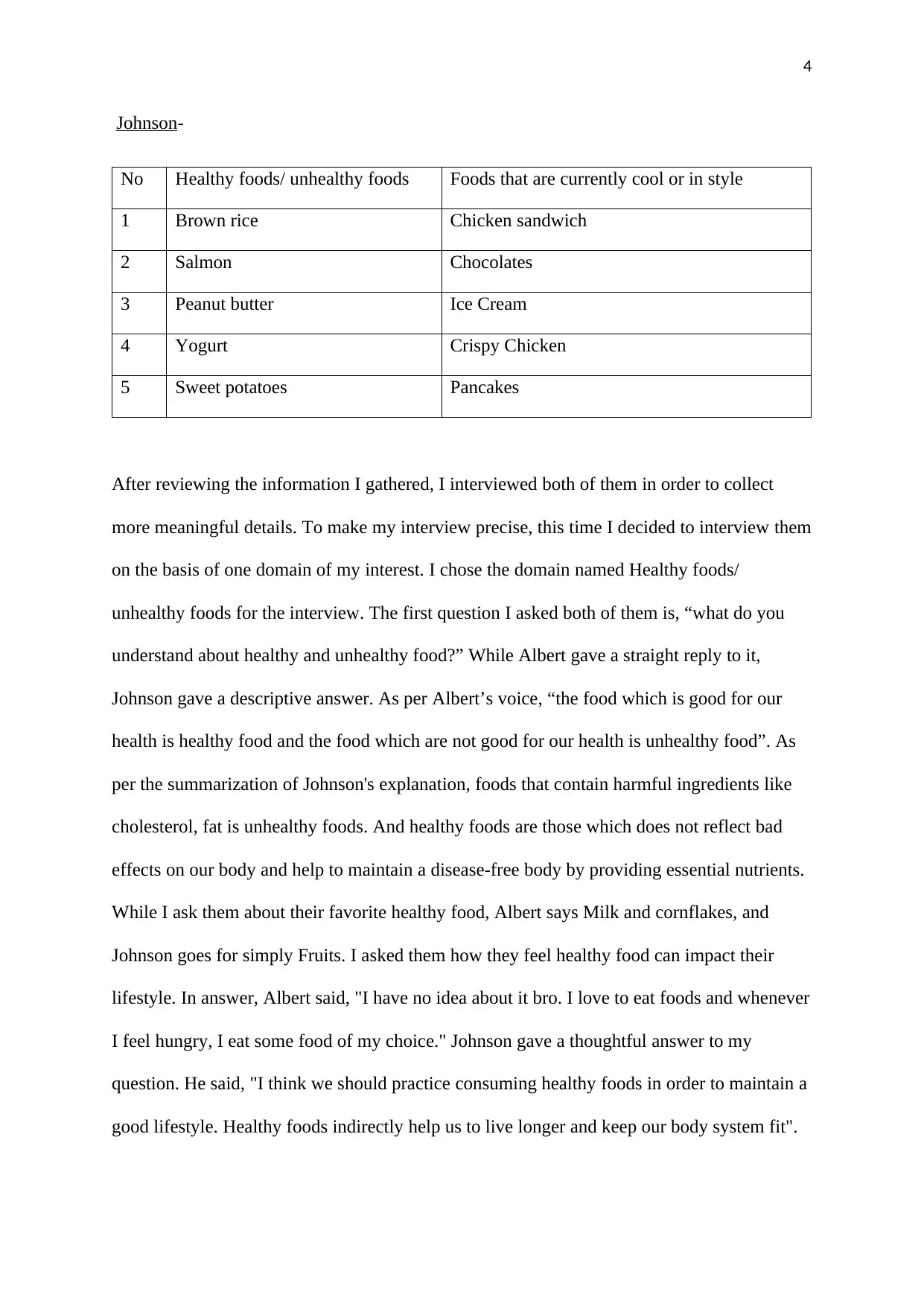
4
Johnson-
No Healthy foods/ unhealthy foods Foods that are currently cool or in style
1 Brown rice Chicken sandwich
2 Salmon Chocolates
3 Peanut butter Ice Cream
4 Yogurt Crispy Chicken
5 Sweet potatoes Pancakes
After reviewing the information I gathered, I interviewed both of them in order to collect
more meaningful details. To make my interview precise, this time I decided to interview them
on the basis of one domain of my interest. I chose the domain named Healthy foods/
unhealthy foods for the interview. The first question I asked both of them is, “what do you
understand about healthy and unhealthy food?” While Albert gave a straight reply to it,
Johnson gave a descriptive answer. As per Albert’s voice, “the food which is good for our
health is healthy food and the food which are not good for our health is unhealthy food”. As
per the summarization of Johnson's explanation, foods that contain harmful ingredients like
cholesterol, fat is unhealthy foods. And healthy foods are those which does not reflect bad
effects on our body and help to maintain a disease-free body by providing essential nutrients.
While I ask them about their favorite healthy food, Albert says Milk and cornflakes, and
Johnson goes for simply Fruits. I asked them how they feel healthy food can impact their
lifestyle. In answer, Albert said, "I have no idea about it bro. I love to eat foods and whenever
I feel hungry, I eat some food of my choice." Johnson gave a thoughtful answer to my
question. He said, "I think we should practice consuming healthy foods in order to maintain a
good lifestyle. Healthy foods indirectly help us to live longer and keep our body system fit".
Johnson-
No Healthy foods/ unhealthy foods Foods that are currently cool or in style
1 Brown rice Chicken sandwich
2 Salmon Chocolates
3 Peanut butter Ice Cream
4 Yogurt Crispy Chicken
5 Sweet potatoes Pancakes
After reviewing the information I gathered, I interviewed both of them in order to collect
more meaningful details. To make my interview precise, this time I decided to interview them
on the basis of one domain of my interest. I chose the domain named Healthy foods/
unhealthy foods for the interview. The first question I asked both of them is, “what do you
understand about healthy and unhealthy food?” While Albert gave a straight reply to it,
Johnson gave a descriptive answer. As per Albert’s voice, “the food which is good for our
health is healthy food and the food which are not good for our health is unhealthy food”. As
per the summarization of Johnson's explanation, foods that contain harmful ingredients like
cholesterol, fat is unhealthy foods. And healthy foods are those which does not reflect bad
effects on our body and help to maintain a disease-free body by providing essential nutrients.
While I ask them about their favorite healthy food, Albert says Milk and cornflakes, and
Johnson goes for simply Fruits. I asked them how they feel healthy food can impact their
lifestyle. In answer, Albert said, "I have no idea about it bro. I love to eat foods and whenever
I feel hungry, I eat some food of my choice." Johnson gave a thoughtful answer to my
question. He said, "I think we should practice consuming healthy foods in order to maintain a
good lifestyle. Healthy foods indirectly help us to live longer and keep our body system fit".
Paraphrase This Document
Need a fresh take? Get an instant paraphrase of this document with our AI Paraphraser
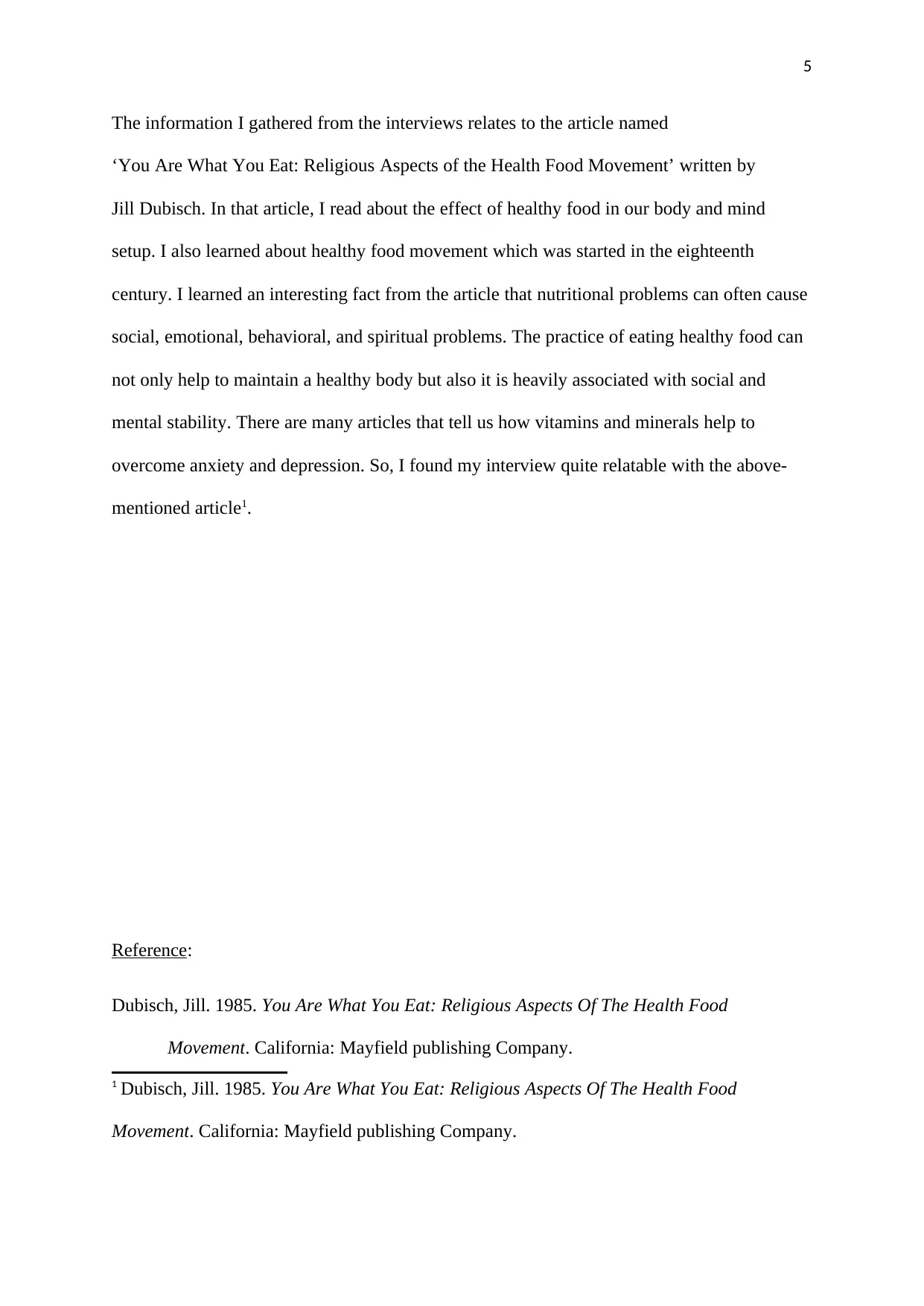
5
The information I gathered from the interviews relates to the article named
‘You Are What You Eat: Religious Aspects of the Health Food Movement’ written by
Jill Dubisch. In that article, I read about the effect of healthy food in our body and mind
setup. I also learned about healthy food movement which was started in the eighteenth
century. I learned an interesting fact from the article that nutritional problems can often cause
social, emotional, behavioral, and spiritual problems. The practice of eating healthy food can
not only help to maintain a healthy body but also it is heavily associated with social and
mental stability. There are many articles that tell us how vitamins and minerals help to
overcome anxiety and depression. So, I found my interview quite relatable with the above-
mentioned article1.
Reference:
Dubisch, Jill. 1985. You Are What You Eat: Religious Aspects Of The Health Food
Movement. California: Mayfield publishing Company.
1 Dubisch, Jill. 1985. You Are What You Eat: Religious Aspects Of The Health Food
Movement. California: Mayfield publishing Company.
The information I gathered from the interviews relates to the article named
‘You Are What You Eat: Religious Aspects of the Health Food Movement’ written by
Jill Dubisch. In that article, I read about the effect of healthy food in our body and mind
setup. I also learned about healthy food movement which was started in the eighteenth
century. I learned an interesting fact from the article that nutritional problems can often cause
social, emotional, behavioral, and spiritual problems. The practice of eating healthy food can
not only help to maintain a healthy body but also it is heavily associated with social and
mental stability. There are many articles that tell us how vitamins and minerals help to
overcome anxiety and depression. So, I found my interview quite relatable with the above-
mentioned article1.
Reference:
Dubisch, Jill. 1985. You Are What You Eat: Religious Aspects Of The Health Food
Movement. California: Mayfield publishing Company.
1 Dubisch, Jill. 1985. You Are What You Eat: Religious Aspects Of The Health Food
Movement. California: Mayfield publishing Company.
1 out of 5
Related Documents
Your All-in-One AI-Powered Toolkit for Academic Success.
+13062052269
info@desklib.com
Available 24*7 on WhatsApp / Email
![[object Object]](/_next/static/media/star-bottom.7253800d.svg)
Unlock your academic potential
Copyright © 2020–2025 A2Z Services. All Rights Reserved. Developed and managed by ZUCOL.





